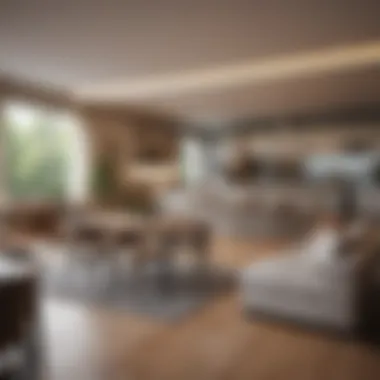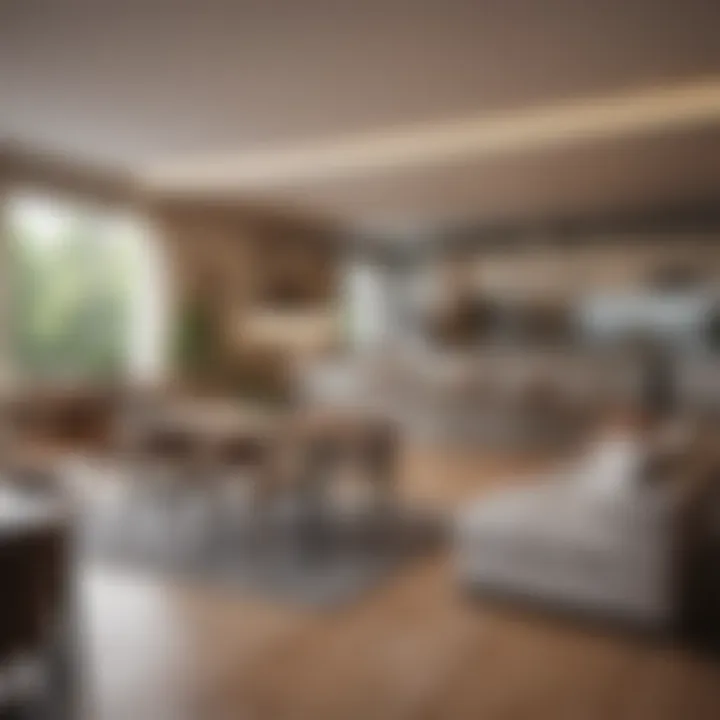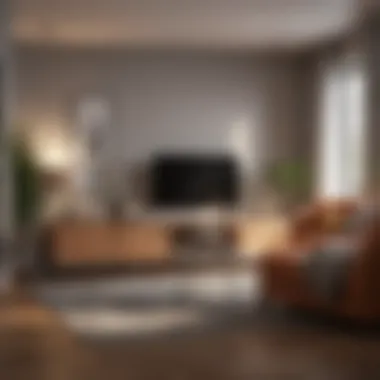Ultimate Guide to One Bedroom Apartment Layouts


Intro
In the realm of urban living, one-bedroom apartments have gained notable traction, becoming a preferred dwelling for many. Understanding various layouts is essential, as they directly influence how space is utilized and how residents interact with their surroundings. This guide aims to explore a blend of traditional and contemporary designs while emphasizing practical strategies for enhancing functionality and aesthetics.
Featured Homes
One-bedroom apartments can vary significantly in layout and design, but recognizing architectural highlights often serves as the first step in understanding their appeal.
Architectural Highlights
The layout of a one-bedroom apartment can be influenced by multiple factors, including the building's age and style. Contemporary designs often feature open floor plans that allow for fluid movement between living areas. This appeals particularly to younger professionals who seek connectivity in their living spaces. Nevertheless, traditional layouts with distinct rooms can offer a sense of privacy, making them favorable for couple or small families.
Key architectural elements to consider:
- Ceiling height: A higher ceiling can create an illusion of larger space.
- Window placement: Strategic positioning can maximize natural light, enhancing the overall ambiance.
- Balcony presence: A small outdoor area can provide additional living space.
Interior Design Themes
The interior design theme of a one-bedroom apartment often reflects the occupant's personality. Choices can range from minimalist to eclectic, with each style boasting unique characteristics.
Popular design themes include:
- Scandinavian: Characterized by simplicity and functionality, this style emphasizes light colors and natural materials.
- Industrial: Raw materials and exposed structures define this theme, offering a unique urban feel.
- Modern: Clean lines and sleek furniture pieces create a contemporary environment.
Each design theme allows for individual expression while ensuring the layout remains practical.
Location Spotlights
The location of a one-bedroom apartment also plays a significant role in its desirability. Urban centers often provide access to essential services, while quieter suburbs offer a different appeal.
Cultural Significance
Cities rich in culture can enhance the experience of living in a one-bedroom apartment, as they often provide residents with easy access to art galleries, theaters, and museums. When selecting an apartment, considering the cultural vibrancy can inform the lifestyle that awaits.
Natural Wonders
Conversely, apartments near natural wonders, like parks or scenic views, can significantly enhance the living experience. Being close to nature can contribute to a sense of tranquility, vital for city dwellers.
"A well-thought-out apartment layout is not just about aesthetics; it reflects the lifestyle choices of individuals and families."
In summary, recognizing the various aspects of one-bedroom apartment layouts is essential for both current and future residents. By exploring architectural features and design themes, one can make informed decisions that enhance living experience in these compact spaces.
Prologue
Understanding the layout of a one-bedroom apartment is essential for both residents and potential buyers. This article aims to provide a thorough exploration of different layouts, the significance of design, and practical strategies for effective space utilization. Layouts not only determine how one interacts with their living space but also influence both functionality and aesthetics. Proper planning ensures that every square foot serves its purpose without feeling cramped or chaotic.
The benefits of knowing various layouts are significant. Different designs can cater to different lifestyles. For instance, individuals who prioritize open spaces might prefer a layout that emphasizes flow and connectivity, while those who value privacy may opt for more traditional configurations. Additionally, understanding market trends can help in making informed decisions when buying or renting.
It is also important to consider factors like furniture arrangement, natural lighting, and personal preferences in decoration. These elements play a vital role in maximizing enjoyment within the confines of an apartment. A well-considered design not only enhances comfort but can also reflect the unique taste of the resident. Consequently, this article discusses these themes in detail, providing insights and practical advice for anyone seeking an optimal living solution in a one-bedroom apartment.
Understanding One Bedroom Apartments
One bedroom apartments represent a significant category within the housing market, appealing to various demographics from young professionals to retirees. Understanding one bedroom apartments is crucial for several reasons. Firstly, they often serve as an ideal living space for individuals or couples who require a balance between comfort and practicality. With increased urbanization, the demand for these apartments has surged. Therefore, grasping their features and potential is essential for buyers, owners, and renters alike.
Definition and Purpose
A one bedroom apartment typically consists of a separate bedroom, a living area, a kitchen, and often one or more bathrooms. This design caters to the need for privacy without excessive space. It suits individuals seeking a cozy home while allowing some layout flexibility. The purpose of these apartments extends beyond mere housing; they provide a lifestyle. Whether it is a calm retreat after a busy day or a social space for friends and family, the one bedroom apartment plays a versatile role. It allows one to personalize their environment while maintaining functionality.
In an urban context, one bedroom apartments are often strategically located near workplaces, transport links, and amenities, making them attractive for both living and investment. They frequently come in differing layouts, allowing residents to choose one aligning with their style and needs.
Market Trends
The real estate market has witnessed a shift regarding one bedroom apartments in recent years. Trends reflect changing lifestyles and economic conditions. For instance, many millennials and Gen Z individuals are prioritizing experiences over possessions, leading to increased interest in smaller, more manageable living spaces.
Reports show a rise in demand for these apartments in metropolitan areas due to urban migration. As cities grow, so too does the appeal of one bedroom apartments that can accommodate busy lifestyles without the burden of larger homes.
Another factor influencing the market is the increasing emphasis on sustainability. Many new developments focus on energy-efficient designs, appealing to environmentally conscious renters and buyers. The blend of aesthetics, functionality, and eco-friendliness makes one bedroom apartments a worthy investment for builders and investors alike.
Understanding the evolving market trends enables potential buyers and renters to make informed decisions.
"The simplicity of a one bedroom apartment can often reflect a more sophisticated approach to living, where every square foot is optimized for comfort and utility."
Essential Layout Components
The layout of a one bedroom apartment is essential. It defines the functionality and flow of the space. Understanding the key components helps residents optimize their living conditions. Proper design leads to improved comfort and satisfaction with the home. Key factors in layout design include the living area, bedroom, kitchen, and bathroom. Each component plays a role in overall usability and aesthetic appeal.
Living Area Design
The living area serves as the heart of the apartment. It is where occupants relax and entertain guests. Essential considerations in this area include furniture placement, space for movement, and light sources. A well-designed living space creates a welcoming environment.
Often, it is beneficial to select furniture that fits the scale of the room. For example, a large sectional sofa may overwhelm a small living area. Choosing smaller, multifunctional pieces can maximize utility and create a sense of openness. Natural light enhances the feel of the space. Large windows or light-colored curtains can effectively brighten the room, making it appear bigger and more inviting.


Bedroom Configuration
The bedroom is where rest and privacy are paramount. Smart configuration is key for comfort and utility. Placing the bed correctly is essential. It should be positioned to allow for easy access from both sides, with pathways clear of obstruction. Additionally, considerations for closet space and storage are crucial. Built-in wardrobes can save floor space, while nightstands provide necessary surface area next to the bed.
The choice of color for walls and bedding also contributes substantially to the overall ambiance of the room. Calming colors, such as soft blues or greens, can create a tranquil space conducive to sleep. It is important to balance aesthetics with functionality.
Kitchen Layouts
Kitchens in one bedroom apartments must prioritize efficiency. Common layouts include galley, L-shaped, and U-shaped designs. Each offers unique benefits depending on space constraints. The galley kitchen is particularly effective in narrow areas, promoting a streamlined workflow.
Appliance placement must be optimized. Keeping the stove, refrigerator, and sink in close proximity enhances cooking experiences. Consider investing in space-saving appliances, such as compact dishwashers or refrigerator models suitable for smaller kitchens.
Storage solutions also play a vital role in kitchen functionality. Utilizing vertical space by adding cabinets or shelves above counters can make the most of limited square footage.
Bathroom Design
A bathroom should balance functionality with comfort. Layout choices can range from simple to elaborate, depending on the available space. Space must be allocated wisely, considering the placement of the shower, toilet, and sink.
In smaller bathrooms, corner sinks or compact vanities can present effective solutions. Including good lighting enhances functionality and presents a welcoming atmosphere. Mirrors also contribute to the illusion of a larger space.
Lastly, the choice of materials should not be overlooked. Water-resistant and durable materials can provide longevity while maintaining style.
Types of One Bedroom Apartment Layouts
Understanding the different types of one bedroom apartment layouts is crucial for anyone involved in real estate, design, or even those just seeking a comfortable living space. Each layout offers distinct advantages and challenges. Choosing a layout impacts functionality, aesthetics, and overall livability. Thus, knowing the varieties available can help potential renters or buyers make informed decisions based on personal needs and preferences.
Traditional Layouts
Traditional layouts are the most common configurations found in one bedroom apartments. They usually consist of a separated living room, bedroom, kitchen, and bathroom. This design emphasizes privacy with distinct areas for different activities.
Benefits:
- Clear Separation of Spaces: Traditional layouts offer defined areas for entertainment, relaxation, and cooking.
- Enhanced Privacy: Bedrooms tend to be away from the living area, allowing for quietness and personal space.
When designing a traditional layout, it's important to consider the flow between rooms. Each area should facilitate ease of movement without feeling cramped. Traditional layouts suit individuals who appreciate a structured environment, making them ideal for professionals or couples.
Open-Plan Layouts
Open-plan layouts represent a distinct shift from traditional designs. These often blend the living room, dining area, and kitchen into a single, expansive space. This style promotes a sense of openness and connectivity, often favored for modern living.
Considerations:
- Social Interaction: The open design fosters interaction among residents and guests, making gatherings more fluid and enjoyable.
- Natural Light: Without walls dividing spaces, natural light can flow freely, creating a brighter living environment.
However, one must account for the potential challenges of noise and lack of privacy. The open nature may not suit everyone, especially those who desire distinct boundaries between work and living areas. Nevertheless, for individuals or small families, open-plan layouts can enhance the living experience through a sense of communal engagement.
Loft-Style Layouts
Loft-style layouts are characterized by their high ceilings and industrial aesthetics, often featuring large windows and exposed beams. Typically, lofts occupy spaces previously used for commercial purposes and can provide a unique charm to the living experience.
Features:
- Flexible Space: Loft layouts often offer versatility in usage. Areas can be adapted for various functions, such as home offices or creative workspaces.
- Character and Aesthetic Appeal: The industrial vibe, along with urban influences, attracts those looking for something distinct from traditional living spaces.
However, the open nature means that residents might need to implement creative solutions for privacy and sound management. Curtains or bookshelves can serve as partitions. Loft-style apartments cater to a more eclectic crowd, including artists and young professionals who appreciate a vibrant living atmosphere.
Overall, selecting the right type of one bedroom apartment layout can significantly affect your lifestyle. Assessing your needs, preferences, and habits will help guide this important decision. As such, it is essential to explore the various options available before committing to a living arrangement.
Space Utilization Strategies
Space utilization is a critical aspect when designing a one-bedroom apartment. The limited size of these apartments demands thoughtful planning and innovative solutions. Efficient use of space not only maximizes functionality but also enhances the overall living experience. Understanding how to optimize every available area is essential for creating a comfortable and inviting home.
Proper space utilization impacts daily living and can also influence property value. This is especially relevant in urban environments where space is at a premium. By strategically considering how each element of the apartment interacts with others, the design can cater to individual lifestyle needs while maintaining aesthetic appeal. In this section, we will focus on two primary strategies: maximizing vertical space and incorporating multi-functional furniture.
Maximizing Vertical Space
Maximizing vertical space is often underestimated yet highly effective. This strategy involves utilizing walls and overhead areas to store or display items. Here are key advantages:
- Increased storage options: By making full use of the wall space, one can add shelves and cabinets that keep the floor clear, which is particularly beneficial in small apartments.
- Aesthetic enhancement: Vertical design elements can draw the eye upwards, making the space appear larger. This is an important consideration in a single bedroom layout.
- Functional versatility: High spaces can serve more than one purpose, like using tall bookshelves as partitioning elements for distinct living areas.
When handling vertical space, consider the following tips:
- Floating shelves: These can be installed in various areas, such as living rooms or kitchens, without taking up floor space.
- Tall furniture: Opt for taller cabinets or units to maximize storage while keeping a streamlined appearance.
- Wall-mounted lighting: This helps eliminate floor lamps, freeing up valuable floor area.
Properly using vertical dimensions can significantly change the perception and functionality of a one-bedroom apartment.
Multi-Functional Furniture
In a one-bedroom apartment, every piece of furniture should ideally serve more than one purpose. Multi-functional furniture is a cornerstone of effective space utilization. This approach minimizes clutter and maximizes functionality.
Consider the following points:


- Versatility: Choose sofas that convert into beds or ottomans that open for storage. Such items help conserve space without sacrificing comfort or style.
- Creative solutions: Look for tables with extendable surfaces or desks that can fold away when not in use. They create room when needed and free up space otherwise.
- Smart designs: Benefits from furniture that integrates storage solutions, such as beds with drawers underneath, can be profound in maintaining an organized living area.
In summary, when space is limited, the importance of furniture arrangement and types chosen cannot be overstated. By effectively implementing strategies for space utilization, creating a one-bedroom apartment that feels spacious and functional becomes an attainable goal.
Furniture Arrangement Tips
Furniture arrangement in a one bedroom apartment plays a crucial role in defining the overall experience of the space. It can enhance both functionality and aesthetics, making it essential for homeowners and design enthusiasts to understand various strategies to optimize their apartments. Thoughtful arrangement allows for better movement within the space, promotes comfort, and maximizes the utility of available square footage. Specific elements such as furniture size, style, and placement can significantly influence how one perceives and utilizes the apartment.
Creating Flow
Creating flow in a one bedroom apartment means establishing a sense of continuity and harmony throughout the living space. This involves paying attention to pathways and ensuring that movement from one area to another is unobstructed. To enhance flow, it is useful to consider the following tips:
- Establish Clear Paths: Arrange furniture in a way that allows for easy navigation. Too many obstacles can make an apartment feel cramped and chaotic.
- Visual Connections: Use design elements that encourage visual connections between areas. This could include using similar styles or colors for furniture in the living room and kitchen.
- Zoning: While maintaining flow, it’s also important to zone different areas. Use rugs or furniture placement to define separate spaces for living, dining, and working while ensuring that these areas connect seamlessly.
By focusing on flow, one can foster a more inviting atmosphere where individuals can transition smoothly from one activity to another.
Defining Distinct Areas
Defining distinct areas within a one bedroom apartment can make the space feel larger and more functional. This ensures that specific functions are served efficiently while maintaining an organized appearance. Here are practical approaches to achieve this:
- Furniture Arrangement: Position larger furniture items, like sofas, against walls to define living areas. Smaller items, such as side tables, can further delineate spaces without overwhelming them.
- Diverse Textiles: Utilize different textiles to differentiate areas visually. For example, using a different type of rug in the dining space compared to the living area helps define these zones.
- Partition Solutions: In situations where more separation is needed, consider decorative screens or bookshelves that can stand as barriers without completely closing off areas.
Utilizing these techniques can create areas dedicated to different activities, enhancing both privacy and functionality. Beyond their visual function, distinct areas allow for more structured routines and living patterns, which can contribute to overall well-being - especially in limited space environments.
Important Note: The key to successful furniture arrangement lies not only in the aesthetic appeal but also in ensuring that the space functions effectively for day-to-day activities.
Impact of Natural Light
Natural light plays a crucial role in one bedroom apartment layouts. It not only enhances the aesthetic appeal but also contributes positively to the overall living experience. Having sufficient natural light can elevate the mood, create a sense of space, and even improve mental well-being. When designing a one bedroom apartment, it is important to consider how natural light interacts with the layout and materials chosen.
The benefits of optimizing natural light are numerous. Firstly, well-lit spaces can reduce the need for artificial lighting, which in turn lowers energy costs. Secondly, natural light can make a small room appear larger and more inviting. Strategically placing mirrors can amplify this effect — reflecting light can create an illusion of depth. Furthermore, exposure to sunlight has been associated with better sleep patterns and increased productivity.
However, one must be mindful of potential drawbacks. Excessive direct sunlight can lead to harmful UV exposure, fading furniture, and creating uncomfortable heat. Balancing light sources while providing opportunities for shade is essential for comfort throughout the day.
Overall, the impact of natural light on a one bedroom apartment layout cannot be overstated. It invites warmth and liveliness, promoting a harmonious living environment.
Designing for Light Sources
When it comes to designing around light sources, there are several key considerations. Firstly, understanding the orientation of a unit affects how light enters the apartment.
- North-facing units often receive indirect light, making it ideal for artists who require an even, soft lighting throughout the day.
- South-facing units tend to receive the most sunlight, which can create brightness for those who enjoy sunlit spaces but they may also experience heat during peak hours.
- East-facing apartments warm up quickly in the morning, while West-facing units capture sunset light, providing natural lighting in the late afternoon.
Additionally, the use of larger windows or glass doors can augment natural light entry. However, thoughtful placement is necessary; designing spaces that avoid glare and excessive heat while maximizing daylight without compromising privacy is key. Incorporating skylights can be a wise solution for a variety of layouts as well.
Choosing Color Schemes
Color schemes can significantly influence how natural light is perceived within a space. Lighter colors tend to reflect light, making a room feel airy and open. Conversely, darker hues absorb light, which can make a place feel cozier or more enclosed. When selecting colors for a one bedroom apartment, it is imperative to consider the type of light available at different times of the day.
- Soft whites and pastel shades allow natural light to bounce around the room, enhancing brightness.
- Cool tones can create a tranquil environment, particularly beneficial in bedroom areas.
- Warm tones or earth shades can provide comfort, particularly in living or dining areas.
In smaller rooms, it might be beneficial to maintain a consistent color palette across walls and furniture to foster an illusion of cohesion. Using accent colors strategically can add character without overwhelming the senses.
"Natural light, paired with well-thought-out colors, defines the ambiance of any living space. "
The overall choice in color should also align with individual taste while catering to how one intends to utilize the space. The right blend can make even the smallest area feel inviting and spacious.
Decorative Elements
Decorative elements play a crucial role in transforming a one bedroom apartment from a simple living space into a personalized sanctuary. The effectiveness of a layout often hinges on how these elements are incorporated. They enhance not only the aesthetic appeal but also the functionality of a space. Selecting the right decorative elements requires a balance between personal taste and practical considerations. These elements contribute to the overall character of the apartment, making it a reflection of its occupant's personality.
Art and Wall écor
The walls of a one bedroom apartment provide a blank canvas, presenting an opportunity for creative expression. Art and wall décor can significantly impact the atmosphere of a room. They add depth, color, and interest, drawing the eye and creating a focal point.
Consider the following factors when selecting art and wall décor:
- Type of Artwork: Choose pieces that resonate with you. This could range from paintings to photographs or even wall hangings. Each piece contributes to the overall vibe.
- Placement: High placement can create an illusion of height, essential in smaller spaces. Aligning art at eye level invites engagement and appreciation.
- Frames and Mounting: The choice of frames can either enhance or detract from the artwork. Minimalist frames suit modern decor, while ornate frames may complement a more traditional style.
Moreover, effective arrangement can create balance and harmony in the space.
"Well-placed art can bring coherence to a room and evoke emotions, guiding the viewer's experience."
Textiles and Fabrics
Textiles and fabrics are essential components that soften the hard edges of a one bedroom apartment. They provide an inviting feel and can significantly influence comfort and aesthetics. The careful selection of fabrics can enhance the spatial experience.
Incorporate textiles in several ways:
- Soft Furnishings: Items such as cushions, throws, and rugs add layers of texture. They provide not just comfort but also visual interest.
- Curtains and Blinds: Choose fabrics that allow you to manage light while contributing to the room's color palette. Sudden changes in light can affect mood; thus, having textile options is valuable.
- Bedding: The bedroom should be a retreat. Consider patterns and colors that relax and please you. An inviting bed layout reinforces the sensation of restfulness.
It is important to remember that durability goes hand in hand with aesthetics when selecting fabrics. Look for materials that withstand daily use but still maintain the stylistic integrity of the space.


Maintaining Privacy
In any one bedroom apartment, maintaining privacy is essential for creating a comfortable living environment. It has significant benefits in fostering a sense of security and enhancing personal space. This aspect is not just about physical barriers but also involves strategic design choices that safeguard personal boundaries while promoting an open and inviting atmosphere.
Effective design for privacy begins with understanding the layout. Consideration must be given to the positioning of living areas, bedroom, and bathroom. For instance, placing the bedroom away from the main living areas minimizes noise disturbances and visual intrusion. A well-considered layout can significantly contribute to a feeling of tranquility, even in the heart of bustling urban environments.
Another vital consideration is the selection of furnishings. Using taller bookshelves or furniture with solid backs can act as natural dividers. Additionally, decorative screens or curtains can create a sense of separation without sacrificing light and openness. These elements can help establish clear boundaries, which are especially useful in smaller spaces where every square inch counts.
Strategic Partitioning
Strategic partitioning is an art in itself. It involves the use of physical and sometimes temporary divisions to create clear boundaries within a one bedroom apartment. This element can help in defining spaces, even when they share the same floor plan. Open-plan layouts often benefit from such partitioning methods, as it allows each area to serve its distinct purpose without overwhelming the occupant.
To implement effective partitioning, consider these strategies:
- Furniture Arrangement: Positioning bookshelves or cabinets can create a natural division between living and sleeping areas.
- Room Dividers: Portable dividers can be a flexible option. They can be repositioned as needed, maintaining functionality while providing privacy.
- Glass Partitions: They can be stylish and allow light penetration while still serving a privacy purpose.
These approaches help in utilizing available space more efficiently and ensuring privacy is not compromised.
Acoustic Solutions
Acoustic solutions go hand in hand with maintaining privacy, as they address sound transfer within the apartment. Noise can be a persistent issue, especially in densely populated areas. Without proper solutions, sounds can easily spill over from one room to another, disrupting the peace.
When considering acoustic solutions, several strategies can be employed:
- Soundproofing Materials: Incorporating sound-absorbing materials like acoustic panels or heavy curtains can help. These items can significantly reduce sound transfer.
- Area Rugs: Flooring choices are important as well. Carpeting or area rugs can dampen footfall noise and contribute to overall sound reduction.
- Sealing Gaps: Ensure that windows and doors are properly sealed to eliminate drafts which can carry sound. This not only improves privacy but also energy efficiency.
By integrating these acoustic solutions, one can achieve a serene and inviting atmosphere. Ultimately, a focused approach to maintaining privacy through strategic partitioning and effective sound management will elevate the living experience within one bedroom apartments.
Sustainability in Design
Sustainability in design has become a critical consideration for one bedroom apartments. This importance derives from the growing awareness of environmental issues and the necessity for efficient resource usage in living spaces. Sustainable design not only minimizes the carbon footprint but also enhances the quality of life for residents. By focusing on eco-friendly materials and energy-efficient appliances, homeowners can contribute positively to the environment while enjoying contemporary and stylish living.
Adopting sustainability in apartment layouts is beneficial for multiple reasons. Firstly, it leads to long-term cost savings through reduced energy bills. Secondly, these kinds of designs often command higher resale values due to the increasing demand among buyers for environmentally conscious features. Additionally, integrating thoughtful and sustainable practices in design helps to create a healthier indoor environment, leading to improved well-being.
Eco-Friendly Materials
When designing a one bedroom apartment, the choice of materials is paramount. Eco-friendly materials are those that are sourced sustainably, have low environmental impact, and promote better air quality indoors. Examples include bamboo flooring, recycled glass countertops, and low-VOC (volatile organic compounds) paints. These materials not only reduce the ecological footprint but also introduce durability and elegance into the design.
Using sustainable materials can require a bit more effort during the selection process, but the benefits often outweigh the initial challenges. For instance, bamboo grows quickly and is highly renewable, making it an excellent choice for flooring. Additionally, recycled materials can often be repurposed in unique and creative ways, leading to a distinctive aesthetic that depends on individual taste. The integration of eco-friendly materials not only aligns with sustainable practices but also enhances the overall appeal of the living space.
Energy-Efficient Appliances
Energy-efficient appliances play a significant role in a sustainable one bedroom apartment. These appliances consume less energy compared to their conventional counterparts, leading to lower utility bills and reduced environmental impact. When selecting appliances such as refrigerators, washing machines, and heaters, look for those labeled with ENERGY STAR certification.
Incorporating energy-efficient appliances into apartment layouts sends a strong message of commitment towards sustainability. Not only do they serve practical functionality, but they also develop a harmonious relationship between efficiency and design. Moreover, the upfront costs of energy-efficient appliances are often compensated by the savings accrued over time. Homeowners can choose smart appliances that adjust energy usage based on demand, offering further benefits in terms of convenience and control.
One study suggests that energy-efficient appliances can save on average $200 per year on energy costs.
Case Studies
Case studies play a vital role in understanding the nuances of one bedroom apartment layouts. They provide real-world examples that illustrate both the successes and challenges faced by residents and designers alike. With an increasingly competitive housing market, examining case studies offers insights into effective space utilization, design innovations, and pitfalls to avoid. This practical information is invaluable for those looking to make informed decisions regarding their living spaces.
When analysing case studies, several specific elements become apparent. First, successful designs often reflect a balance between functionality and aesthetics. Observing what makes these designs work reveals key trends in homeowner preferences. Moreover, studying common pitfalls helps to identify what not to do when designing or renovating a one bedroom apartment. This dual focus on achievements and mistakes enhances the learning experience for anyone engaged in interior design or real estate.
By exploring these case studies, readers gain an array of benefits:
- Enhanced understanding of various layout dynamics.
- Insights into innovative design techniques.
- Awareness of the impact of personal style on functionality.
- Recommendations for maintaining harmony in small spaces.
"Case studies provide a valuable lens through which the complexities of apartment design can be analysed and understood."
Overall, delving into case studies is not merely an academic exercise. It serves as a foundation for practical application in design projects, making it essential for homeowners looking to create spaces that resonate with their lifestyles.
Successful One Bedroom Designs
In successful one bedroom designs, several aspects contribute to creating a harmonious living environment. The most effective designs prioritize open spaces with a clear flow that encourages natural movement. This can be seen in layouts that minimize obstructive furniture and utilize smart storage solutions effectively.
Utilization of vertical space is a common trend in successful designs. For instance, floor-to-ceiling bookshelves or cabinets not only save space but also provide an opportunity for personal touches through decoration.
Another noteworthy element is the choice of materials and color schemes. Lighter hues tend to create an illusion of spaciousness. Moreover, incorporating natural elements like wood can enhance aesthetics while keeping them warm and inviting. Diverse furniture styles can be mixed, allowing for an eclectic yet cohesive look that reflects personal taste.
Common Pitfalls to Avoid
While there are many inspiring examples, it is crucial to learn from mistakes that can derail the functionality of one bedroom apartments. One common pitfall is overcrowding a space with furniture. Overstuffed rooms can feel claustrophobic, which defeats the purpose of having a peaceful living environment. It is critical to ensure that furniture is appropriately scaled to the space available.
Another frequent error is neglecting storage. In a small apartment, supply ample storage solutions to prevent clutter from accumulating. Built-in cabinets and multi-functional furniture should be key considerations.
Poor lighting also remains a common issue. Neglecting to optimize natural light can make small apartments feel dreary. Careful placement of mirrors and smart lighting choices can significantly improve the overall ambiance of the apartment.
Lastly, overlooking personal style in favor of trends can lead to discontent over time. It is essential to design a space that reflects personal taste, rather than adhering strictly to what is currently fashionable.
Finale
In this article, we have traversed the multifaceted realm of one bedroom apartment layouts. Each component, from the living area design to privacy maintenance, plays a crucial role in crafting a livable and welcoming space. By focusing on effective design strategies and space optimization, homeowners and renters can transform their apartments into true reflections of their lifestyles and preferences.
The significance of layout cannot be overstated. A well-thought-out plan can enhance not only the functionality but also the overall aesthetics of a home. One bedroom apartments, despite their compact size, offer boundless potential for imaginative designs. This is particularly important in today’s market where innovation and efficiency are highly valued among real estate enthusiasts.
In particular, we emphasized the importance of natural light and sustainable design choices, understanding how these elements can greatly improve the quality of living. Choosing eco-friendly materials and energy-efficient appliances are not just considerations for personal comfort but also contribute positively to the environment.
Furthermore, appropriate furniture arrangement can create distinct zones within a single space, allowing for an efficient flow. The insights gained from various case studies presented in this article illustrate common pitfalls while celebrating successful designs. This dual perspective equips readers with the necessary knowledge to make informed decisions, avoiding the typical mistakes seen in common layouts.







